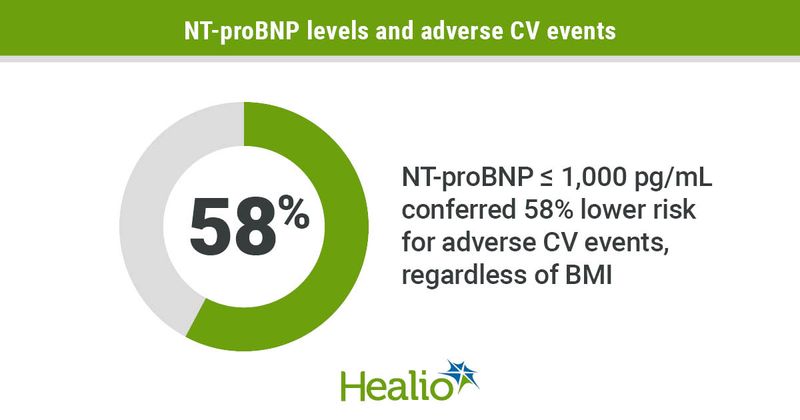Elevated NT-proBNP confers adverse CV events in HFrEF regardless of BMI
Among patients with HF with reduced ejection fraction, elevated N-terminal pro-B-type natriuretic peptide level was associated with greater risk for HF hospitalization and CV mortality, regardless of BMI, researchers reported.
As Healio previously reported, the GUIDE-IT trial determined that a NT-proBNP-guided strategy did not benefit patients with HFrEF any more than usual care. The GUIDE-IT trial was halted for futility after enrolling 864 patients (median age, 63 years; 32% women). For the present analysis, researchers compared results based on obesity status.

“Obese patients have lower NT-proBNP levels. The prognostic implications of achieving NT-proBNP levels 1,000 pg/mL in obese patients with HF receiving biomarker-guided therapy are not completely known,” Vibhu Parcha, MD, clinical research fellow in the division of cardiovascular disease at University of Alabama at Birmingham, and colleagues wrote. “We evaluated the prognostic implications of obesity and having NT-proBNP levels ( 1,000 pg/mL) in the GUIDE-IT trial participants.”
Overall, NT-proBNP levels were 59% lower among obese individuals (95% CI, 39.5-83.5).
Researchers observed that risk for adverse CV events, as defined as HF hospitalization or CV mortality, was lower among patients with HF and NT-proBNP levels of 1,000 pg/mL or less compared those with higher NT-proBNP patients, regardless of whether patients had obesity (HR = 0.48; 95% CI, 0.29-0.59) or not (HR = 0.32; 95% CI, 0.19-0.57; P for interaction > .1).
In multivariable-adjusted models, NT-proBNP level of 1,000 pg/mL or less was associated with an approximately 58% lower risk for adverse CV outcomes (HR = 0.42; 95% CI, 0.29-0.59; P < .001), according to the study.
Moreover, patients with obesity experienced greater risk for HF hospitalization or CV mortality compared with patients without it (HR = 1.39; 95% CI, 1.01-1.9; P = .04).
According to the study, NT-proBNP level was the strongest correlate for risk for HF hospitalization or CV death among patients with HFrEF; this was true for those with obesity and those without it.
“The lack of a treatment target in HFrEF, especially in the setting of limited physical examination, such as in obesity, leaves the titration of HF treatment to the physician’s discretion,” the researchers wrote. “Even with the high prevalence of inadequate medication up-titration, reaching NT-proBNP levels of 1,000 pg/mL holds prognostic importance.”
